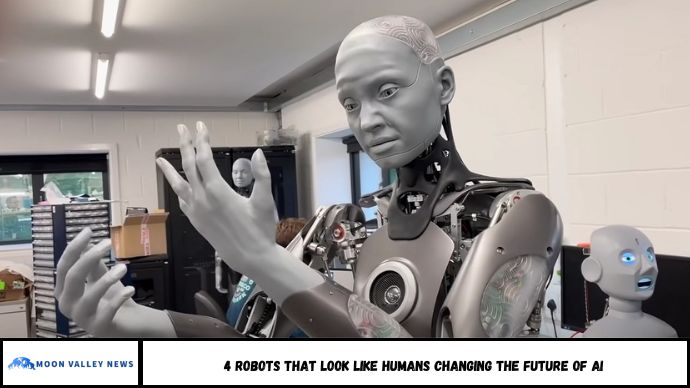That quote sounds like science fiction, but it’s quickly becoming reality. Advances in artificial intelligence and robotics have made it possible to build robots that not only function like humans but look like them too.
Why does human appearance in robots matter? Because people respond better to machines that feel familiar. Whether in caregiving, education, or customer service, human-like robots offer intuitive interaction, emotional comfort, and an easier learning curve.
Humanoid robots have long fascinated storytellers and scientists alike. From the replicants in Blade Runner to the eerily lifelike Ava in Ex Machina, these fictional machines raise deep questions about identity, consciousness, and what it means to be human.
For decades—some might say even centuries—engineers and roboticists have been working to turn that science fiction into reality. While progress has been remarkable, there’s still a psychological barrier: why do human-like robots often make us uncomfortable? Researchers suggest it’s because they blur the lines between human and machine, challenging our sense of self.
Yet despite this discomfort, humanoid robots are already proving their value. Studies, including one published in the journal Children in 2022, have shown that these robots can assist children with autism in developing social and communication skills.
While today’s machines haven’t fully crossed the “uncanny valley,” the line between artificial and organic continues to blur. Below, we explore four of the most advanced robots that look remarkably human—almost indistinguishably so.
In this article, you’ll discover:
- Four of the most lifelike humanoid robots in the world
- The technology behind their realistic design
- How these androids are used in practical applications
- What the future holds for human-looking AI
Let’s look at how science fiction has become a visible part of our present—and where it’s going.
1. Sophia – The Most Famous Humanoid Robot
Developer: Hanson Robotics
Origin: Hong Kong
Year Introduced: 2016
Sophia is the world’s most recognized humanoid robot, known for her human-like skin, expressions, and ability to hold conversations. She made headlines as the first robot to receive citizenship (from Saudi Arabia) and has appeared in international interviews, conferences, and talk shows.
Key Features:
- Mimics over 60 facial expressions
- AI-driven natural conversation
- Recognizes emotional tone and visual cues
Sophia’s appearance and responses are designed to encourage trust and engagement, especially in social and educational settings.
Interesting Fact: Sophia’s “skin” is made of a patented material called Frubber, which mimics the flexibility of real human skin.
2. Ameca – The Most Expressive Robot Ever Built
Developer: Engineered Arts
Origin: United Kingdom
Year Introduced: 2021
Ameca stands out for its ultra-realistic facial movements and advanced expressiveness. Though not built to resemble a specific person, its neutral face and fluid gestures have made it one of the most photorealistic robots today.
Key Features:
- Real-time facial reactions
- Modular design for easy hardware and software updates
- Built as a platform for AI development
Ameca is commonly used for demonstrations of advanced AI-human interaction and is regularly updated to keep pace with AI advancements like natural language processing.
3. Geminoid DK – The Robot Twin
Developer: Hiroshi Ishiguro Laboratories
Origin: Japan
Year Introduced: 2011
Geminoid DK is part of a series of robots that look exactly like real individuals. This model is a robotic twin of Danish professor Henrik Scharfe, created for research into human presence and telecommunication.
Key Features:
- Highly realistic human clone
- Operated remotely for speaking and motion
- Used in psychology, communication, and robotic behavior studies
Geminoid DK is part of a larger study into how people perceive machines and how closely robots can imitate human presence and behavior.
4. Nadine – The Social Companion Robot
Developer: NTU Singapore
Origin: Singapore
Year Introduced: 2013
Nadine is a companion robot modeled after her creator, Professor Nadia Thalmann. Unlike many humanoids, Nadine has memory, personality, and emotional intelligence, making her suitable for roles in elder care and customer support.
Key Features:
- Recognizes individuals and remembers previous conversations
- Capable of facial expression and speech
- Used in social interaction and mental health therapy
Nadine is especially relevant as the global population ages. The World Health Organization predicts a shortfall of over 15 million health workers by 2030, and robots like Nadine are being developed to help fill that gap.
Why Are Human-Like Robots Important?
Human-like robots are designed not just for visual appeal, but to improve communication and reduce resistance to technology. Key advantages include:
- More natural interaction for users
- Better emotional connection and empathy
- Easier learning curve for non-technical users
- Usefulness in roles requiring trust and comfort (e.g., caregiving)
They are especially effective in high-touch environments where human interaction is key, such as healthcare, customer service, and education.
Future Trends in Humanoid Robotics
The humanoid robotics industry is expected to grow rapidly in the coming years. According to a 2024 report by Markets and Markets, the global humanoid robot market is projected to reach $15.5 billion by 2030, driven by demand in healthcare, hospitality, and personal assistance.
Technological advances contributing to this growth include:
- More powerful and energy-efficient AI processors
- Sophisticated voice and speech synthesis
- Better skin and movement materials that replicate human behavior
As these robots become more lifelike and capable, their integration into daily life is expected to increase substantially.
Frequently Asked Questions (FAQs)
1. What are humanoid robots?
Humanoid robots are machines designed to resemble and behave like humans in appearance, motion, and interaction.
2. Are there robots that look identical to real people?
Yes. Robots like Geminoid DK are built as near-perfect replicas of actual people, down to facial features and expressions.
3. Can robots like Sophia feel emotions?
No. They simulate emotional responses based on algorithms but do not experience real emotions.
4. Where are humanoid robots used today?
They are used in education, healthcare, research, entertainment, and customer-facing roles.
5. How much does a humanoid robot cost?
Prices range from $20,000 to over $100,000, depending on complexity and purpose.
6. Are lifelike robots dangerous?
No. They are built with safety protocols and designed for public interaction, not physical strength or autonomy.
Conclusion
Robots that look like humans are no longer concepts in science fiction—they’re working prototypes and deployed solutions across the globe. Whether it’s Sophia’s public engagement, Ameca’s expressive face, Geminoid DK’s uncanny realism, or Nadine’s empathetic companionship, these humanoids are changing how we think about technology.
As AI continues to evolve, the gap between human and machine continues to shrink. Staying informed about these developments isn’t just interesting—it’s essential for anyone preparing for the next wave of innovation.
Ready to learn more? Follow the evolution of AI-powered robots and discover how they’ll shape the next decade of human-machine collaboration.







